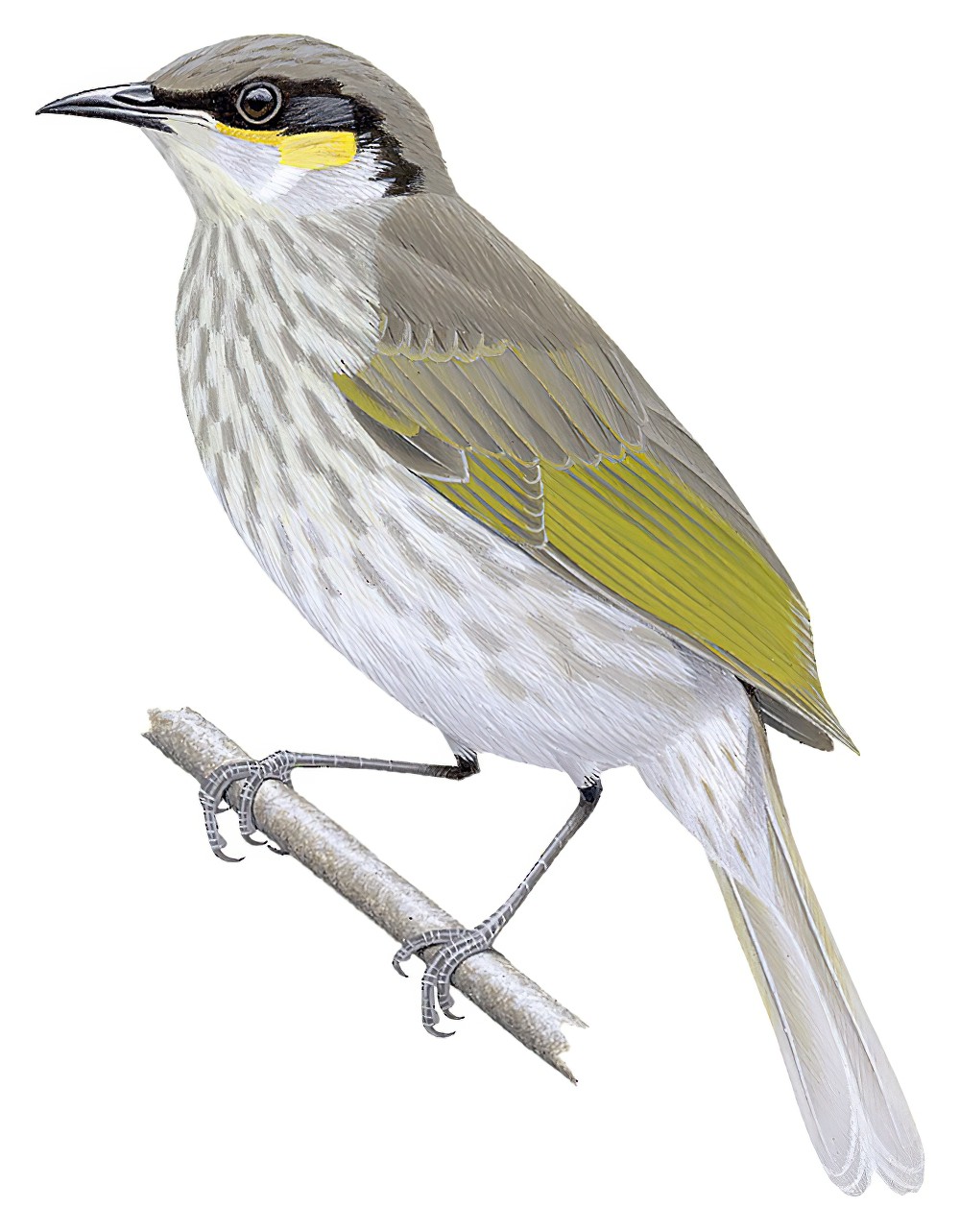Singing Honeyeater / Gavicalis virescens

Singing Honeyeater
SCI Name:
Protonym: Melithreptus virescens Nouv.Dict.Hist.Nat. 14 p.329
Taxonomy: Passeriformes / Meliphagidae / Gavicalis
Taxonomy Code: sinhon1
Type Locality: further restricted to Bernier Island by Mees, 1961, Journ. Roy. Soc. Western Australia, 44, p. 122; cf. also Stresemann, 1951, Emu, 51, p. 69.
Author: Vieillot
Publish Year: 1817
IUCN Status: Least Concern
DEFINITIONS
GAVICALIS
(Meliphagidae; † Singing Honeyeater G. virescens) Anagram of genus Caligavis Iredale,1956, honeyeater; "(ii) Gavicalis Schodde & Mason, subgen. nov.: ventrally streaked grey-brown or citrine body plumage with or without flavonoids, extensive narrow blackish eye stripe, diffusely yellowish malar stripe under eye extended into diffusely yellow auricular plume, no white post-ocular spot or dusky submalar stripe, and pale upper neck patch diffuse, whitish and merging with diffuse auricular plume. Two species in Australo-Papuan woodlands and coastal scrubs and mangroves; both in Australia: versicolor Gould, virescens Vieillot. As noted by Wolters (1975-82), this group has not been formally described, and so is named here ... TYPIFICATION OF NEW TAXA: subgenus Gavicalis Schodde & Mason: type species: Lichenostomus virescens (Vieillot). Gavicalis is an anagram of Caligavis." (Schodde & Mason 1999); "Gavicalis Schodde and Mason, 1999, The Directory of Australian Birds. Passerines, p. Type, by original designation, Lichenostomus virescens (Vieillot) = Melithreptus virescens Vieillot, 1817." (JAJ 2021).
virescens
L. virescens, virescentis greenish < virescere to become green < virere to be green.
● ex “Agile Parrot” of Latham 1781, and “Petit Perroquet verd” of Levaillant 1801-1805 (syn. Amazona agilis).
● ex “Psittaca cayenensis” of Brisson 17690, “Petite perruche verte de Cayenne” of d’Aubenton 1765-1781, pl. 359, “Perruche à ailes variées” of de Buffon 1770-1783, and “Yellow-winged Parrakeet” of Latham 1781 (syn. Brotogeris versicolurus).
● "76. ARDEA. ... virescens. 15. A. occipite subcristato, dorso viridi, pectore rufescente. Ardea stellaris minor. Sloan. jam. 3. p. 315. t. 263. Raj. av. 189. n. 2. Catesb. car. 1. p. 80. t. 80. Habitat in America." (Linnaeus 1758) (subsp. Butorides striata).
● ex Muscicapa querula A. Wilson, 1810 (Empidonax).
● ex “Tordo Dragon” of de Azara 1802-1805, no. 65 (Pseudoleistes).
SUBSPECIES
Singing Honeyeater (cooperi)
SCI Name: Gavicalis virescens cooperi
cooperi / cooperii
● William Cooper (1798-1864) US zoologist, collector, conchologist, founder member of the Lyceum of Natural History, New York (Accipiter, ?syn. Calidris acuminata x C. ferruginea, Contopus, subsp. Myiarchus tyrannulus).
● Dr James Graham Cooper (1830-1902) US ornithologist (son of William Cooper), botanist, explorer, collector (syn. Buteo jamaicensis harlani, syn. Melospiza melodia heermanni, subsp. Piranga rubra, syn. Podiceps grisegena holboellii).
● Coopers Camp, Melville I., Northern Territory, Australia (subsp. Gavicalis virescens, syn. Myiagra ruficollis mimikae).
● “I have named this species, at the request of Mr Zeledon, the collector of the type-specimens, after Mr Juan Cooper, of Cartago, Costa Rica, a particular friend of his, to whom he is much indebted for many interesting contributions to his collections” (Ridgway 1878) (Megascops).
● "adult male donated by Major A. L. Cooper, by whom it was collected near Salisbury, S. Rhodesia [= Zimbabwe], early in August, 1947" (Roberts 1947) (syn. Pternistis swainsonii x Pternistis afer) (OD per Björn Bergenholtz).
Singing Honeyeater (sonorus)
SCI Name: Gavicalis virescens sonorus
sonorus
L. sonorus resonant, loud < sonor, sonoris noise < sonare to make a noise < sonus noise.
Singing Honeyeater (virescens)
SCI Name: Gavicalis virescens virescens
virescens
L. virescens, virescentis greenish < virescere to become green < virere to be green.
● ex “Agile Parrot” of Latham 1781, and “Petit Perroquet verd” of Levaillant 1801-1805 (syn. Amazona agilis).
● ex “Psittaca cayenensis” of Brisson 17690, “Petite perruche verte de Cayenne” of d’Aubenton 1765-1781, pl. 359, “Perruche à ailes variées” of de Buffon 1770-1783, and “Yellow-winged Parrakeet” of Latham 1781 (syn. Brotogeris versicolurus).
● "76. ARDEA. ... virescens. 15. A. occipite subcristato, dorso viridi, pectore rufescente. Ardea stellaris minor. Sloan. jam. 3. p. 315. t. 263. Raj. av. 189. n. 2. Catesb. car. 1. p. 80. t. 80. Habitat in America." (Linnaeus 1758) (subsp. Butorides striata).
● ex Muscicapa querula A. Wilson, 1810 (Empidonax).
● ex “Tordo Dragon” of de Azara 1802-1805, no. 65 (Pseudoleistes).
Singing Honeyeater (forresti)
SCI Name: Gavicalis virescens forresti
forresti / forrestia
● George Forrest (1873-1932) Scottish botanist, explorer, collector in the Himalayas, Tibet and south-western China (subsp. Dryocopus javensis, subsp. Hypothymis azurea, subsp. Lioparus chrysotis, Phylloscopus, subsp. Pomatorhinus superciliaris, syn. Streptopelia tigrina, syn. Trochalopteron chrysopterum woodi).
● Sir John Forrest 1st Baron Forrest of Bunbury (1847-1918) Australian politician, explorer, first Premier of Western Australia 1890-1901 (subsp. Gavicalis virescens).
● Forrest River, Western Australia (subsp. Mirafra javanica).
UPPERCASE: current genus
Uppercase first letter: generic synonym
● and ● See: generic homonyms
lowercase: species and subspecies
●: early names, variants, mispellings
‡: extinct
†: type species
Gr.: ancient Greek
L.: Latin
<: derived from
syn: synonym of
/: separates historical and modern geographic names
ex: based on
TL: type locality
OD: original diagnosis (genus) or original description (species)












